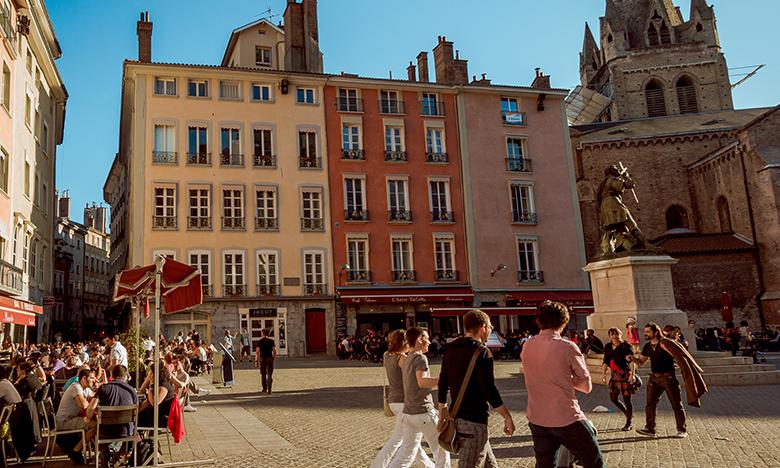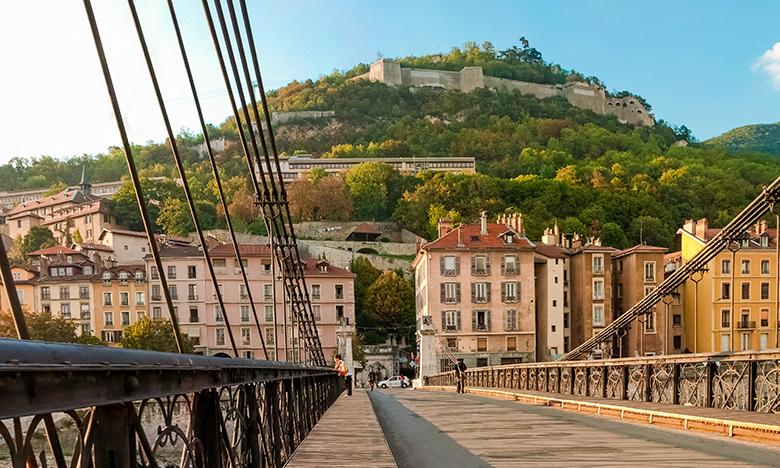For more information, visit the Grenoble Tourism Office at www.grenoble-tourisme.com.
City region: The Alps / Auvergne-Rhône-Alpes
Population & what they are called: 163,625 inhabitants (2014 census), called Grenoblois
Access from Paris:
by road: about 5 h 15 min (357 miles) via A6 autoroute du Soleil
by train: about 3 hours by TGV from the Gare de Lyon
Famous native daughters & sons:
Stendhal, writer
Calogero, singer
Jean-Claude Gallotta, dancer and choreographer
Most distinctive and/or unique fact or trait (or little known fact):
Some historians date the start of the French Revolution to the Day of Tiles (Journée des Tuiles), a revolt that took place in Grenoble on June 7, 1788.
Grenoble has the second largest English-speaking community in France, after Paris.
Notable sites:
Fort de la Bastille – old fortifications built on the mountainside, reached by cable car, with superb views of the city
Vieille Ville – historic center filled with cobblestone streets and picturesque squares
Palais du Parlement du Dauphiné – Renaissance palace used as the Dauphiné Parliament until the French Revolution
Top annual events:
Rencontres Ciné Montagne – a unique mountain-centric festival of films, workshops and conferences, the biggest of its kind in Europe (grenoble-montagne.com)
Grenoble Street Art Fest – Europe’s first festival of street art as a multidisciplinary art, featuring frescoes, collages, stencil work, sculptures, photography, digital art, videos and more (streetartfest.org)
Cabaret Frappé – a free, summer, open-air music festival (cabaret-frappe.com)
Most notable museums:
Musée de Grenoble – renowned for its extensive paintings collection, but also sculptures and antiquities (museedegrenoble.fr)
Musée Archéologique Grenoble-Saint Laurent – presents the archeological excavations done on location (musee-archeologique-grenoble.fr)
Musée de la Révolution Française – located in the Vizille Chateau, the only museum in the world dedicated to this key period in French history (domaine-vizille.fr)
Culinary specialties:
walnuts – in 1938, the noix de Grenoble was the first fruit to receive an Appellation d’Origine Contrôlée (AOC)
cheese – two local-area standouts are Saint-Marcellin and Bleu du Vercors Sassenage
murçon de la Matheysine – local boiled pork sausage with aniseed flavor
Local wines & spirits:
Chartreuse – the only liqueur in the world with a completely natural green color, a product of distilled alcohol aged with 130 herbs, plants and flowers
Bières de Sassenage – one of the beers produced at the Brasserie des Cuves is called Sacrebleu, the first European blue beer with a 100% natural color (brasseriedescuves.fr)
Shopping:
Vieille Ville et Championnet – shops selling designer clothes, art and amazing chocolates
Halles Sainte-Claire – a huge, classic, covered market packed with fruits, vegetables, pastries, cheeses, meats etc.
La Caserne De Bonne – 50 shops in the De Bonne eco-district
Most popular night spots:
La Belle ÉlÈctrique – artistic and cultural project that spotlights amplified music: jazz, rock, pop, techno, fusion and more
La Bobine – concerts, bar, restaurant, exhibitions, theater etc.
Mark XIII – Friendly bar with DJ electro sets and cyber-goth-punk atmosphere
Local population’s favorite activities (or hangouts):
Jardin des Dauphins – the city's most luscious garden and a perfect place for a sunny stroll
MC2 (for Maison de la culture) – Grenoble's main cultural center, which hosts music, theater, and dance performances (mc2grenoble.fr)
Local industries:
FrenchTech – Grenoble was recognized for its growth in high-tech industries, including biotechnology and nanotechnology
scientific research – Grenoble is a major scientific research center (second only to Paris) focused on physics, computer science and applied mathematics
In Pop Culture:
electronic music – pioneered in Grenoble since the 1990s by the likes of The Hacker (Michel Amato), Miss Kittin, Oxia and others
The Trilogy (On the Run [Cavale], An Amazing Couple [Un couple épatant] and After Life [Après la vie]) – three separate feature films by Lucas Belvax, each set in Grenoble over the same few days in the lives of six characters
13 Days in France (13 jours en France) — a documentary about the 1968 Winter Olympics in Grenoble, directed by Claude Lelouch and François Reichenbach
About Top French Cities - www.francepresskit.com
Top French Cities is an association of 29 cities, from regional capitals like Bordeaux to important towns like Avignon and Versailles. They are perfect for young travelers, families and anyone else looking for fun and authentic French experiences that will fit their budget. Most of these cities are university towns with a youthful atmosphere, but all of them reflect the heritage and distinctive flavors of the regions to which they belong. Many are forward-looking too, with historic buildings repurposed to house contemporary art and activity centers like Les Docks in Marseille. Many have created or integrated new, modern museums to contrast with their classical, architectural heritage, like in Nimes, where the cutting-edge Museum of Roman Civilization (Musée de la Romanité) is located across from the historic Roman amphitheater, or in Nantes, where whimsical mechanical creatures are being created, or in the UNESCO World Heritage Site concrete city of Le Havre.



